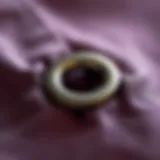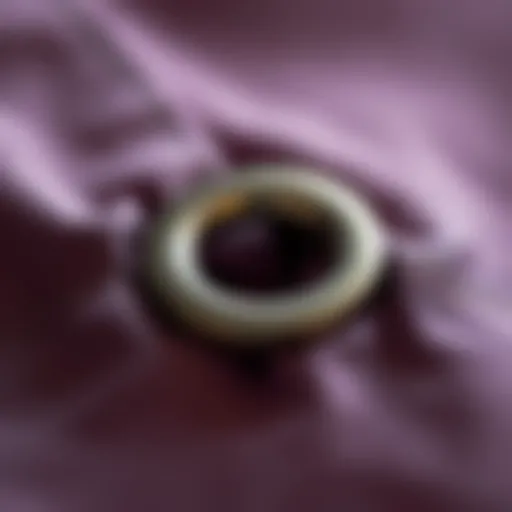Exploring the Art and Utility of Round Clay Beads
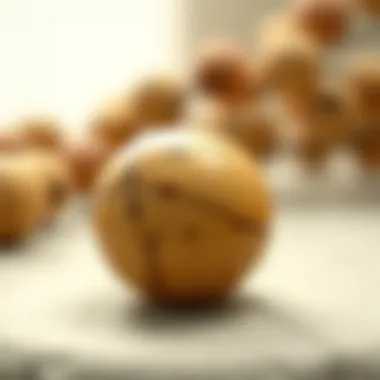

Intro
Round clay beads, often overlooked in the fast-paced world of fashion, hold a treasure trove of history and artistry. These humble orbs of earth carry the stories of ancient cultures, the creativity of artisans, and the subtleties of modern style. This article aims to shine a light on the myriad ways these beads intersect with our lives today—from their rich past to their contemporary applications in aesthetics and functionality.
Each bead, meticulously crafted from clay, is not just a decorative item but a testament to the skill and dedication of those who create them. Their design reflects a balance of utility and artistry, making them an essential element for fashion enthusiasts, stylists, and creators alike. By exploring the layers of significance and usage, we hope to engage a discerning audience eager to deepen their understanding of this versatile medium.
As we journey through the fascinating world of round clay beads, we will cover their historical significance, manufacturing techniques, artistic methods, and environmental impacts. Additionally, we will offer practical advice on maintaining these beautiful creations and discuss their role in the modern craft movement. Prepare to unravel the complexities of round clay beads, broadening your appreciation for their inherent charm and capacity for creativity.
Historical Context of Clay Beads
Understanding the historical context of clay beads is essential to appreciate their multifaceted roles throughout time. These small, round artifacts are not mere decorative items; they encapsulate human expression, cultural identity, and even economic transactions. From ancient rituals to contemporary fashion, clay beads have stitched themselves into the fabric of our lives, serving as a testament to the artistry and ingenuity of various civilizations. Exploring this context sheds light on how round clay beads have evolved and adapted, mirroring shifts in societal values, aesthetics, and connectivity among communities.
Ancient Origins and Cultural Significance
The journey of clay beads begins thousands of years ago, where they served vital roles in ancient civilizations. Evidence suggests that earliest clay beads date back to the Neolithic era, around 7000 BC, discovered in regions like Mesopotamia and along the banks of the Nile. Cultures utilized these beads in a myriad of ways, like personal adornment, trade, and ritualistic purposes. Their production often coincided with significant cultural milestones, too.
- Personal Identity: For many tribes, wearing clay beads was a form of self-expression. Beads often indicated status, lineage, or tribal affiliation. For instance, in some Indigenous communities, specific colors or shapes told stories that bonded people to their heritage.
- Monetary Systems: In ancient trade, such as in the Silk Road exchanges, beads emerged as currency. Their inherent value was not just in raw materials but in craftsmanship and symbolism, indicating wealth and access to resources.
- Ritual Importance: Clay beads often played a critical role in spiritual rites. They were incorporated into burial practices or ceremonial garb, enshrining the belief that they could offer protection or blessings to the wearers.
The stories these beads tell are rich. Beyond fashion, they are bridges to lost cultures, echoing the dreams, fears, and identities of those who came before us. Their use in art and communication underscores humanity's enduring need for connection, both with each other and with the spirits of our ancestors.
Evolution Through the Ages
As societies evolved, so did the significance and construction of clay beads. Transitioning from hand-crafted tribal designs to the intricate artistry of different eras illustrates this evolution.
- The Rise of Sophistication: By the time of the Roman and Greek empires, clay beads became highly stylized. Artisans experimented with glazing techniques, introducing colors and patterns that reflected the environments and ideologies of their times. Little did anyone know that these developments would lay the groundwork for future artisans.
- Renaissance Innovations: Transition to the Renaissance saw a rejuvenation of arts, including beadwork. Here, Italian artisans infused new techniques inspired by classical antiquity. Beads became part of elaborate jewelry pieces, making their way into royal courts and the wardrobes of the affluent.
- Modern Adaptations: Fast forward to the 20th century — unique styles emerged with the likes of the Bead Movement in the 1960s, where artists embraced clays’ versatility. They morphed once again, merging into the realms of fashion, breaking traditional barriers and aligning with contemporary social movements.
Today, round clay beads hold an eclectic mix of meanings. They sit comfortably in both indigenous craftsmanship and modern fashion trends. The parallels drawn through history highlight not just the raw material's potential but also humanity's collective spirit, adapting and integrating through various epochs, signifying that beauty and utility can exist hand-in-hand.
"The style of clay beads is more than just about aesthetics; it is about understanding a lineage and storytelling that binds us together collectively through time."
Manufacturing Processes of Round Clay Beads
The manufacturing processes of round clay beads form the backbone of their creation, standing at the crossroads of art and technique. Understanding these processes is vital not just for artisans and crafters, but also for fashion enthusiasts and retailers who wish to appreciate the craftsmanship behind these versatile accessories. Knowing how they are made can inform choices in purchasing while also enhancing creativity in design. This section endeavors to explore the intricacies involved in the production of round clay beads, examining the materials, techniques, and processes that contribute to their unique characteristics and appeal.
Materials Used in Production
The foundation of any clay bead lies in the materials employed. Primarily, clay, which can be sourced from various regions, serves as the essential ingredient in bead making. There are different types of clay, each imparting distinctive qualities to the final product. Common choices include:
- Earthenware: Great for beginners, this clay is low-fired, making it affordable and easy to work with. Its porous nature allows for vibrant glazing once fired.
- Stoneware: Known for its durability, stoneware can be fired at higher temperatures, thus yielding a more robust and less porous bead. This type is ideal for functional pieces.
- Porcelain: Often regarded as the more refined choice, porcelain results in a smooth, elegant finish that appeals to high-end markets.
In addition to clay, additives such as grog (crushed fired clay) or colorants may be introduced to achieve specific textures and hues. Selecting the right materials is essential to achieving the desired aesthetic and functional properties.
Techniques for Shaping and Forming
Once the materials have been chosen, the shaping and forming of clay beads becomes the focal point of the manufacturing process. Various techniques can be employed to transform raw clay into aesthetically pleasing beads:
- Hand-rolling: This traditional method involves rolling clay into balls by hand, allowing for a wide range of sizes and imperfections that add character.
- Molds: For those seeking uniformity, using molds can ensure consistent shapes. Molds can be made from various materials, often leading to precise forms and designs.
- Coiling and Pinching: These ancient techniques allow for intricate designs. Coiling involves layering ropes of clay to create a bead, while pinching shapes it through finger manipulation, encouraging a direct connection between the artist and the piece.
Each technique offers unique advantages and can influence the shape and texture of the final product, resulting in varied artistic expressions.
Firing and Glazing Processes
The last piece of the puzzle involves firing and glazing, crucial steps in achieving durability and color on clay beads. Firing transforms malleable clay into a hardened material that can withstand wear and tear. There are two general types of firing:
- Bisque Firing: This initial firing removes moisture and weakens the clay slightly, preparing it for glazing. Typically, this is done at lower temperatures.
- Glaze Firing: In this step, the bisque-fired beads are coated with glaze and refired at higher temperatures. This process leads to a glossy finish and enhances color, making them visually appealing.
Glazing not only serves aesthetic purposes but also provides a protective layer which makes the beads easier to clean and more resilient to damage. Without proper glazing, clay beads may be vulnerable to moisture and scratches.
Artistic Techniques in Clay Bead Design
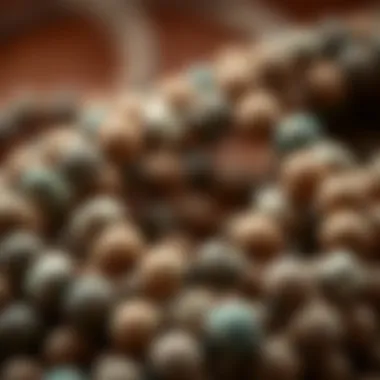

The realm of clay bead design is a captivating intersection where artistic expression meets functional craftsmanship. Focusing on artistic techniques opens up a treasure chest of possibilities, allowing artisans to breathe life into seemingly simple materials. For fashion enthusiasts, stylists, and retailers, understanding these techniques is crucial, as they can significantly impact both the aesthetic appeal and marketability of clay bead products.
Crafting round clay beads isn't merely an act of production; it's an art form that often reflects cultural heritage and personal expression. These techniques enhance the beads' appeal, ensuring each piece tells its own story. Techniques such as surface texturing and color application serve not only as a creative outlet but also establish a connection to the evolving landscape of fashion trends.
Surface Texturing and Decoration
Surface texture can elevate a bead from ordinary to extraordinary, creating a tactile experience that draws attention. Consider how a simple bead may enhance its charm with a variety of texturing techniques. Techniques such as stamping, carving, or even bead wrapping allow for intricate designs. Some artisans may even use found objects, like leaves or lace, to imprint unique patterns.
Common texturing methods include:
- Carving: Creating depth and dimension by removing material from the surface.
- Stamping: Using tools to imprint designs onto the clay, adding precise detail.
- Gluing Natural Elements: Incorporating organic materials, like sand or crushed shells, for a distinctive flair.
Such techniques not only personalize the bead but also evoke emotions and tell stories. Decorative elements might also include beads being painted or coated in different finishes, adding layers that catch the eye and provoke curiosity. These considerations are paramount for anyone in the fashion industry looking to curate uniquely appealing collections.
Benefits of Surface Texturing
- Aesthetic Appeal: Textured surfaces capture light and shadow, creating dynamic visual effects.
- Enhanced Tactility: A distinct feel increases the user’s engagement with the product.
- Cultural Storytelling: Patterns can express a connection to heritage, making beads more meaningful.
"The details in art often provide depth, not just in flavor but also in significance."
Color Application Methods
Color application methods in clay bead design can be the cherry on top of an already beautiful creation. These methods are far more than just adding a splash of color; they serve to communicate emotions, create themes, and foster deeper connections with wearers. Different techniques, such as glazing, painting, or applying natural dyes, offer artisans a palette to work from.
Some prevalent color application techniques include:
- Glazing: Applying a layer of glassy coating that adds shine and protects the bead. Glazes can be mixed to create a spectrum of hues.
- Underpainting: First painting with a base color and then applying additional layers for depth and vibrancy.
- Natural Dyes: Using plant, fruit, or mineral-based dyes to create unique shades, often connecting the product to sustainability trends.
Color plays a powerful role in fashion. It dictates market trends and influences consumer preferences. Therefore, artists who master these color application techniques not only distinguish their creations but also make strategic choices that align with current styles and expectations.
Importance of Color Methods
- Visual Impact: Striking colors attract attention and increase desirability.
- Mood and Theme: Colors can convey emotions, directly impacting the wearer's sentiment.
- Trendy Appeal: Distinct color combinations can align with seasonal trends, making products more appealing to a wider audience.
By focusing on artistic techniques, designers can cultivate a deeper appreciation for round clay beads. With the right mix of texture and color, beads transcend their basic utility, becoming significant objects of art that resonate within the ever-evolving landscape of fashion.
Utilization of Round Clay Beads in Fashion
Round clay beads have long transcended their origins as mere components of adornments. They stand at the crossroads of cultural narratives and artistic expression within the fashion industry. Their significance extends beyond aesthetics; they embody stories, emotions, and the timeless interplay between tradition and contemporary style. In this section, we will explore how round clay beads are utilized in various facets of fashion, highlighting their versatility, the benefits they offer, and the various considerations that come into play when integrating these unique beads into modern design.
Accessories: Jewelry and Beyond
Round clay beads find a remarkable place in the creation of accessories, especially in the realm of jewelry. Their textured surfaces and rich variety of colors enable artisans to craft vibrant pieces that speak to both personal style and cultural heritage. When it comes to necklaces, bracelets, and earrings, these beads can be strung in myriad ways – from simple, single-strand designs to intricate, multi-layered creations. The combination of different sizes and finishes can result in visually striking contrasts that elevate any outfit.
Some key advantages of using round clay beads in jewelry include:
- Eco-friendliness: Made from natural materials, they offer a sustainable alternative to synthetic options.
- Customizability: Artisans can create unique works that reflect personal stories or regional influences.
- Cultural Expression: Many round clay beads carry significant cultural symbols, thus connecting wearers to traditions.
Moreover, beyond traditional jewelry-making, round clay beads have inspired innovations in various accessory types, including bag charms, home decor items, and decorative elements in fashion garments. This versatility enables wearers to express their individuality while maintaining a connection to artisanal craftsmanship.
Integration in Apparel Design
When it comes to apparel design, round clay beads can transform ordinary clothing into striking fashion statements. Designers are experimenting by embedding these beads in various garments, particularly in details like cuffs, collars, and hemlines, offering an unexpected accent that captures the eye.
Utilizing beads in apparel comes with a few strategic considerations:
- Weight and Balance: Adding substantial beads can make fabrics feel heavy or unbalanced, so thoughtful placement is imperative.
- Washability: Depending on the bead material and finish, ensuring that garments can withstand washing without damaging the beads is essential.
- Target Audience: Understanding the preferences and lifestyle of the target demographic can inform decisions regarding bead style and placement.
Furthermore, integrating round clay beads into apparel lends itself to storytelling. Designers can use beads with specific cultural significance to convey messages or evoke emotions through their collections. This approach not only elevates fashion but also fosters deeper connections between the wearer and the crafted piece.
Cultural Fashion Trends and Influences
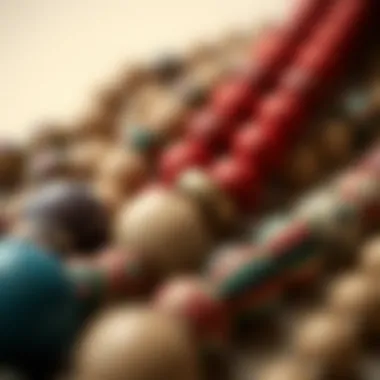

The influence of round clay beads in cultural fashion trends is profound. These beads often serve as a canvas for cultural narratives, bridging the gap between history and modern-day style. By incorporating round clay beads into fashion, designers honor traditional craftsmanship while also inviting contemporary audiences to appreciate the heritage behind these pieces.
Cultural fashion trends that embrace round clay beads often include:
- Bohemian and Ethnic Styles: Drawing inspiration from global traditions, these styles celebrate the handmade essence of round clay beads.
- Sustainable Fashion Movements: As consumers increasingly seek eco-friendly options, round clay beads, with their organic nature, fit seamlessly into the ethos of sustainable style.
- Artisanal Collaborations: Celebrated artists and designers are joining forces with local artisans skilled in clay bead crafting, enriching the fashion landscape with unique, culturally-infused designs.
As the fashion world grapples with the dual challenges of sustainability and authenticity, the integration of round clay beads serves as a powerful reminder of the rich narratives that can arise from a humble material. They resonate not just as accessories but as symbols of enduring connections between history, culture, and the art of fashion.
“Fashion is about the expression of identity. Round clay beads allow for that, encapsulating stories from the past within contemporary design.”
In summary, the utilization of round clay beads in fashion illustrates a multidimensional approach to style, creativity, and cultural appreciation, allowing both creators and consumers to engage in a meaningful dialogue through clothing and accessories.
Environmental Considerations in Clay Bead Production
The production of round clay beads is not just about artistry; it also comes with significant environmental responsibilities. As the popularity of these handcrafted items rises, so does the need to address their ecological footprint. Understanding the importance of environmental considerations helps artisans and consumers alike make informed choices about their creations and purchases. This section explores the issues surrounding sustainability and the effects of production techniques in clay bead manufacturing.
Sustainability of Materials
The journey of a round clay bead begins with materials that often originate from the earth. Clay is generally abundant, but the methods used to source and process it can either embrace sustainability or undermine it. Sustainable sourcing involves the careful selection of resources to minimize environmental degradation. For example, some artisans prioritize using locally sourced clay which not only supports regional economies but also cuts down on transportation emissions—making the process more eco-friendly.
Additionally, other materials combined with clay, such as eco-friendly glazes and natural dyes, add a layer of sustainability. The choice of these materials can significantly impact the environment. Using non-toxic pigments, for instance, reduces the risk of contaminating surrounding ecosystems. A commitment to sustainability can help artisans appeal to environmentally conscious consumers who prioritize green products.
"Every bead tells a story, and the materials we choose can speak volumes about our values towards the planet."
Impact of Production Techniques
The techniques used to create round clay beads hold substantial sway over their environmental impact. Traditional methods, like hand molding and low-energy kilns, can lead to lower carbon footprints compared to industrialized mass-production processes. Many artists choose to fire their beads in kilns that are designed to optimize energy efficiency, thus conserving resources while still ensuring high-quality outcomes.
Moreover, waste management practices during production play a crucial role. Artisans are increasingly adopting strategies that reduce waste, such as recycling scraps and reusing excess clay in future projects. These practices diminish the need for raw materials and help close the loop on the production cycle.
The use of digital tools and platforms for designing and selling clay bead creations can also lower the material impact, as they encourage a more refined approach to creating only what is desired, minimizing overproduction.
As consumers become more discerning, the demand for sustainably produced clay beads is likely to dictate trends in production and design. This shared responsibility between artists and buyers could foster a new wave of practices that not just prioritize beauty, but also preserve the beauty of our planet, making clay beads an art form of conscience.
Care and Maintenance of Clay Bead Products
The significance of proper care and maintenance for clay bead products cannot be overstated. These unique items are not only crafted for aesthetic appeal but also serve practical purposes in various applications. Treating them with care ensures that they remain vibrant, functional, and free from damage. Well-preserved clay beads continue to tell their stories through art, fashion, and craftsmanship, embodying cultural narratives and personal expression. Furthermore, maintaining their integrity can enhance their longevity, making them a worthwhile investment for collectors and fashion enthusiasts alike.
Cleaning and Storage Practices
Keeping your clay bead products clean is essential for their durability and overall appeal. Here are some best practices that will help you maintain their charm:
- Dust Regularly: Use a soft, dry cloth to gently wipe beads and remove any dust build-up. Avoid harsh chemicals that might tarnish or damage the surface.
- Gentle Cleaning: If necessary, a mildly damp cloth can be employed to clean more stubborn dirt. Be cautious not to soak the beads, as excessive moisture can lead to deterioration.
- Safe Storage: Store your clay beads in a cool, dry place away from direct sunlight. Box or pouch storage minimizes the risk of scratches or breakage.
- Use acid-free tissue paper to wrap each item individually, preventing friction and contact with other materials.
- Consider adding silica gel packets to absorb any potential moisture that could settle in the storage area.
Using these methods can ensure that your clay beads retain their beauty and structural integrity for many years.
Repairing and Restoring Damaged Beads
Accidents can happen, and even the sturdiest of clay beads can find themselves in a tight spot. Here’s how to handle repairs with finesse:
- Assessing Damage: First, take a good look at the damage. Is it a crack, chip, or a break? Identifying the nature of the damage will dictate the appropriate fix.
- Selecting Adhesives: For smaller cracks or chips, specialized adhesive designed for ceramics or crafts should do the trick. Be cautious while applying; you want it to be a neat job!
- Reconstruction: If a bead is broken into two pieces, align them perfectly and apply adhesive evenly. Use clamps or a weight to hold them in place while they dry.
- Finishing Touches: Once repaired, often you may want to repaint or touch up to restore the bead’s original appearance. Use appropriate paints or sealants that complement the existing finish.
Repairing clay beads not only saves a cherished item but also symbolizes a commitment to sustainability by reducing waste. It may also imbue the item with a new story to share, making it even more valuable.
"Taking care of your clay beads reflects not only appreciation for craftsmanship but also smart stewardship of materials."
To delve deeper into the maintenance of clay beads, resources such as Wikipedia or articles on Britannica may provide additional insights into various practices.
Round Clay Beads in Contemporary Craft Movements
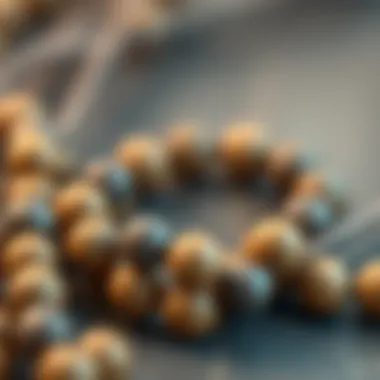

The rise of contemporary craft movements has paved the way for a greater appreciation of traditional materials and techniques. Round clay beads stand at the forefront of this renaissance, not merely as decorative items but as vehicles of artistry and cultural expression. Their role is fundamental, influencing both aesthetic choices and the philosophies behind creating art today.
One cannot underestimate the value that round clay beads bring to the table. They are crucial in emphasizing the handmade ethos in a world increasingly dominated by mass production. Crafters and artists are taking a step back, moving away from factory-made goods to embrace the tactile, personal nature of handcrafted items. This movement resonates deeply within the clay bead community, which champions authenticity and connection to the creator’s intent.
Revival of Handcrafted Techniques
The revival of handcrafted techniques is a heartbeat in many crafting genres today. Round clay beads, often molded by hand and uniquely decorated, embody this trend beautifully. The tactile experience of shaping clay allows artists to engage in a dialogue with their materials; each bead tells its own story.
In this context, one can observe:
- Diversity in Design: Artists are now free to explore various shapes, textures, and color palettes, diverging from traditional norms to create fresh, innovative pieces.
- Cultural Relevantation: Many artisans are drawing inspiration from ancient methods, blending tradition with modern aesthetics, thus reviving age-old craft practices infused with contemporary relevance.
- Local Sourcing: There is also an increasing interest in locally sourced clays and natural embellishments that resonate with local cultures and identities.
As these handcrafted techniques reemerge, they bring forth not just beautiful objects, but also narratives that highlight community and heritage. The artisanal approach nurtures a sense of pride in craftsmanship and encourages potential consumers to value the story behind the piece rather than its price tag alone.
Educational Empowerment Through Workshops
Workshops focusing on round clay beads are blossoming within communities, acting as hubs for educational empowerment. These gatherings offer hands-on education in clay molding and bead crafting, bringing together people of various ages and backgrounds. A key benefit of such workshops lies in their potential to:
- Foster Skills: Participants gain practical skills that both democratize crafting and democratize artistic expression. People can take familiar materials and, through basic techniques, transform them into intricate art.
- Cultural Exchange: Importantly, these workshops facilitate dialogue among diverse crafters, encouraging cultural exchange and the sharing of techniques from around the globe.
- Encourage Sustainable Practices: Many educational programs also emphasize sustainable practices by teaching participants how to source materials responsibly and minimize waste during the crafting process.
Participants leave these workshops not only with newfound skills but also with a deeper understanding of the artistic process, the value of community engagement, and an appreciation for the cultural narratives that round clay beads represent.
"Craft is not just a product of labor; it's a reflection of community, identity, and culture."
Consumer Trends in Clay Bead Products
The landscape of consumer demand for round clay beads is continually shifting, reflecting broader aesthetic movements, sustainability concerns, and cultural influences. In the digital age, where trends can change overnight, understanding these consumer patterns is crucial for stylists, retailers, and artists alike. It's not merely about the product—it's about the stories they weave and the connections they foster within communities.
Market Demand and Styles
The current market for clay beads is characterized by an eclectic blend of styles, which cater to various tastes and preferences. From bohemian ensembles to minimalist designs, the round clay bead serves as a versatile element that can accentuate a wide range of fashion statements.
- Colorful and Playful: Many consumers lean towards vibrant colors, often influenced by seasonal trends. Tie-dyed patterns and bright hues echo the zeitgeist of youth culture, appealing especially to a younger demographic.
- Earthy and Natural: Conversely, earth-toned beads have skyrocketed in popularity among eco-conscious consumers. Made from locally sourced materials, these beads resonate with those who wish to incorporate nature into their lifestyle.
- Personalized Touch: Another significant trend is customization. Consumers are increasingly seeking unique pieces that reflect their personality. Artisans are now creating bespoke clay bead sets that allow individuals to mix and match, ensuring that no two pieces are alike.
As trends come and go, the importance of understanding consumer preferences cannot be understated. By keeping a finger on the pulse of the market, businesses can tailor their offerings, ensuring a lasting appeal.
Artist Collaborations and Unique Designs
In recent times, partnerships between artists and brands have led to a surge in creativity around round clay beads. These collaborations produce pieces that are not just accessories but works of art.
Collaborating artists often bring their distinct visions, transforming simple clay beads into statement pieces.
- Cultural Influences: These designs often reflect various cultural backgrounds, enriching the product's narrative. For instance, an artist inspired by traditional Maori patterns may infuse their work with motifs that speak volumes about their heritage.
- Limited-Edition Releases: The market has also seen a rise in limited-edition collections, further emphasizing the uniqueness of these collaborations. Consumers eager for exclusive items are willing to invest more in these distinct pieces, which can lead to higher sales for the brands involved.
- Social Media as a Catalyst: Platforms like Instagram and Pinterest amplify visibility, allowing artists to showcase their creations to a global audience. This instant reach influences consumer purchasing decisions, driving demand for unique designs that stand out in the crowded marketplace.
"In a world where mass production is commonplace, the allure of unique, handcrafted items is more coveted than ever."
As we navigate through the intricate interplay of artistry and commerce, it's evident that the fusion of creativity and consumer awareness is key to understanding the contemporary landscape of clay bead products.
For further explorations into the impact of consumer trends on clay bead design and production, visit resources like Wikipedia or consult Britannica.
Ending
The discussion surrounding round clay beads encapsulates not just the artistry but also the essence of human creativity throughout history. These small objects carry with them a narrative that transcends mere aesthetic enjoyment; they embody culture, craftsmanship, and innovation. Understanding their role provides insights not only into the art of bead-making but also the intricate ways these objects impact fashion and sustainability.
Recapitulation of Key Insights
Gathering the insights presented throughout this article, several key elements firmly establish round clay beads as significant in both historical and modern contexts:
- Cultural Significance: Round clay beads have been a part of diverse cultures for centuries, serving both decorative and ritualistic purposes. From ancient adornments to contemporary fashion statements, their evolution reflects societal values and artistic expressions.
- Sustainability Factors: In an era where environmental concerns are paramount, the sustainability of materials used in clay bead manufacturing has come to the forefront. Organic materials and eco-friendly processes are increasingly favored, aligning with the principles of conscientious consumption.
- Artistic Techniques: The artistic techniques employed in the design and creation of these beads range from hand-painting to innovative glazing methods, showcasing the technical capabilities of artisans. Knowledge of these methods enriches appreciation and could inspire future craft endeavors.
- Market Trends: Consumer preferences are shifting towards unique, handcrafted products—where round clay beads play a significant role. The collaboration between artists and brands gives rise to distinctive designs that resonate with a market eager for authenticity.
Future Directions in Clay Bead Exploration
Looking ahead, the future of round clay beads appears promising, with several noteworthy directions that merit attention:
- Integration with Technology: As technology advances, there's potential for incorporating digital tools in bead design. This shift could lead to innovations in both the aesthetics of the beads and their manufacturing processes, making them more appealing to tech-savvy consumers.
- Educational Workshops: Initiatives that promote clay bead-making workshops are gaining momentum. These educational avenues not only revitalize traditional crafting techniques but also foster community engagement.
- Customization Trends: Personalized products are the darling of today's consumers. Clay beads could capitalize on this by offering customers the chance to design their own beads, incorporating specific colors or motifs that hold personal significance.
- Cross-Cultural Exchanges: The rich history of clay beads in diverse cultures can provide a rich tapestry for collaboration among artists. Such exchanges could inspire entirely new forms and designs, bringing fresh vitality to the traditional aspects of clay bead art.
In summary, round clay beads represent more than a decorative item; they are a medium through which we can explore cultural narratives, artistic expression, and sustainable practices. The potential for future exploration seems limitless, with opportunities for growth and innovation aplenty.










